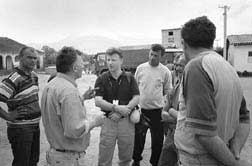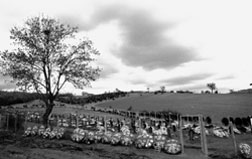 |
|
Bodies to Dust | "No One Would Dare Stop Us" Milosevic's Hidden Hand? | Zahac's "Disappeared" Blood Money | Revenge or Justice Images of a Massacre On a cold, wet morning in early winter, Shaqir Gashi returned to a place of horror and of small miracles. Gashi, a 65-year-old ethnic Albanian farmer, scanned the muddy slope just outside a remote hamlet in central Kosovo named Izbica. At this site, more than 21 months ago, ethnic Albanians suffered one of the most brutal atrocities of the war, the summary executions of more than 120 men and boys by Serbian troops. Dressed in work clothes and boots, Gashi recalled how Serbian forces surrounded thousands of Albanians taking refuge at Izbica on March 28, 1999. It was just four days into NATO's air campaign against Yugoslavia. The villagers were hoping Izbica's remote location, local Albanian guerrillas and stalking NATO warplanes would protect them from the onslaught. But their hopes faded when Serbian forces began shelling the village and sent in paramilitary shock troops. Soon after Serbian soldiers entered Izbica, they began separating men from their families. Women and children were expelled while the unarmed men were led away. Most ethnic Albanians of fighting age—knowing they faced execution if caught—fled the Serbian advance, so the captured group consisted mainly of elderly men and teenage boys. Shaqir Gashi was among them. The Serbian forces divided the Albanians into smaller groups. They led Gashi and dozens of other men to a small hill. Gashi spoke slowly: "As we were watching them expel our families they yelled at us, 'Sit down!' Then they ordered us to turn away from them. ... One shouted 'Now!' Then the machine gun opened fire ... grrrrrrrr."
In the grainy video, the camera zooms in on the face of each victim, some of them horribly disfigured. The name of each victim is spoken. Soon after the burials, a spy satellite hundreds of miles overhead also captured images of the freshly dug graves at Izbica. Those reconnaissance photos, the home video (which was smuggled out of Kosovo), and the stories told by survivors fleeing Kosovo alerted the UN War Crimes Tribunal in The Hague. Tribunal investigators were working feverishly to prepare an indictment against Serbian leader Slobodan Milosevic and his senior staff for the mass expulsions and murders underway in Kosovo. Some Tribunal staff believed a speedy indictment against Milosevic could deter even greater violence in Kosovo. UN investigations commander Dennis Milner said documentary evidence of the killings at Izbica were a vital part of Milosevic's eventual indictment. "This particular scenario was so compelling because of the numbers involved for one mass killing, [so] we targeted Izbica as an indictment site," Milner said. Milner's team scoured the refugee camps in Albania and Macedonia to debrief Izbica survivors like Gashi. Izbica was also important to western governments, but not just for issues of justice and deterrence. Three weeks into NATO's aerial bombardment of Yugoslavia, Serbian forces were refusing to budge from Kosovo and criticism of the campaign was mounting in western countries. If the aim of the massive air campaign was to save Albanian lives, Izbica was an acute example of a failing strategy. Increasingly pressed by a wary public, U.S. and European officials sought to rally public support for the war. They looked to Izbica. Next page: A Calculated Risk |

